San Francisco singer-songwriter Sonny Smith has a project called 100 Records: He made up 100 fake bands/artists, and wrote songs, created backstories, and so on, for each. An exhibit featuring the covers of the 100 records that resulted is at Gallery 16 in SF. I think this is the related blog. More info here, and here.
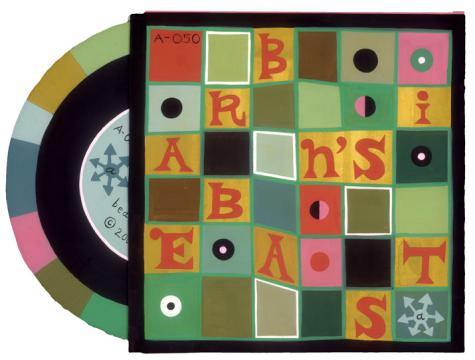
Thanks: Steve P.!
Posted Under:
Imaginary Brands,
Music
This post was written by Rob Walker on April 10, 2010
Comments Off on Imaginary bands
 IPAD ENVY
IPAD ENVY
Giving early adopters what they want.
What these people are likely to get for their consumption daring is a chance to experience every single glitch or flaw that will be tweaked and patched in the months ahead. Also the guarantee that they’re paying full price (just like the early adopters who paid $600 for an iPhone in June 2007; the price was cut to $400 two months later, and angry adopters were mollified by a $100 store credit ). And how surprised will they be if a year from now Apple introduces a new, cheaper and decisively better iPad? Sure, they get first-on-the-block bragging rights — assuming that it turns out iPad adoption proves worth bragging about. Somebody was first to buy the Newton, the Edsel and any number of other products that we don’t even remember the names of anymore, because later adopters never materialized….
Read the column in the April 11, 2010, New York Times Magazine, or here.
Discuss, make fun of, or praise this column to the skies at the Consumed Facebook page.
Posted Under:
Consumed
This post was written by Rob Walker on April 10, 2010
Comments Off on In The New York Times Magazine: Early adopter = sucker move?
- The iPad Luddites: “Progress may, for a time, intersect with one’s own personal ideology, and during that period one will become a gung-ho technological progressivist. But that’s just coincidence. In the end, progress doesn’t care about ideology. Those who think of themselves as great fans of progress, of technology’s inexorable march forward, will change their tune as soon as progress destroys something they care deeply about.”
- Cildo Meireles’s Coca-Cola Project: “Meireles removed Coca-Cola bottles from normal circulation and modified them by adding critical political statements, or instructions for turning the bottle into a Molotov cocktail*, before returning them to the circuit of exchange.”
- Branding Deals Come Early in the Filmmaking Process – NYTimes.com: Now, having Campbell’s Soup or Chrysler associated with your project can be nearly as important to your pitch as signing Tom Cruise.
- 200 Examples of anti-Obama merchandise: During health care debate, 2008-2010. Via Coudal.
These links compiled via delicious, and repurposed here with plug-in Postalicious. Not enough stuff? Not the stuff you wanted? Try visiting unconsumption.tumblr.com, murketing.tumblr.com, and/or the Consumed Facebook page.
Posted Under:
Non-Daily Linkpile
This post was written by Rob Walker on April 10, 2010
Comments Off on Linkpile
Friend of Murketing Randy Ludacer points out two pieces by Steve Roden that are relevant to this site’s occasional series on the idea of the book.

Steve Roden. Click for more.
From 1999, a piece called Observatory.
the piece was inspired by a quote from joseph cornell’s diary regarding the 5 things he always saw from his kitchen window. he oftern referred to his kitchen as his ‘observatory’. 5 tape loop compositions were composed; each using one of cornell’s 5 things seen. there were electronically transformed tape loops from the sounds of birds, trees, sun (in this case the sounds of the sun harnessed through a magnifying glass burning a contact mic), snow (tv static) and rain.
each of the 5 loops was placed in a cassette player that was concealed in a hollowed out book. each book had a speaker embedded in its spine, so that the audio equipment was concealed and the sounds seemed to quietly eminate from the books. MORE
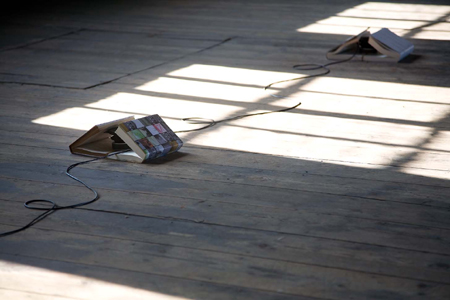
Steve Roden. Click for more.
And from 2008: “When books are like butterflies.”
i began by notating every sound in the book as well as every color that appears in sequence, and used these lists to generate a sound work, a text work, and a set of images. the installation consisted of a series of 15 sculptural forms, each using two books and an audio speaker. the text and images exist in the form of printed dust jackets which cover the books, and visually frame the sound as it eminates from the speaker. the text follows the description of every sound in the book, in sequence, with each text also following the color sequence of the book. the images are mostly background images from victorian photographs i have collected over the years, that somehow relate to the generator of every sound in the text (such as swan’s wings, or a bell). MORE
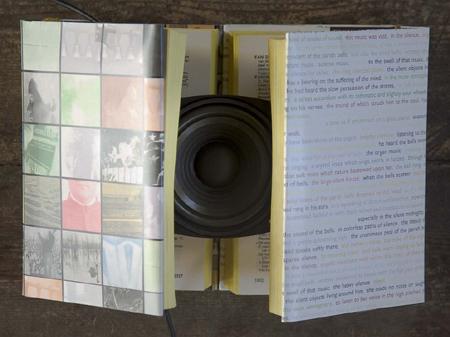
Steve Roden. Click for more.
Posted Under:
Artists,
Music
This post was written by Rob Walker on April 8, 2010
Comments Off on The idea of the book, cont’d: As source of music
I mentioned that I’d have a couple of bits of news from the Significant Objects project that might be of interest to Murketing readers. Here’s one bit.
Today’s story (part of our Paola Antonelli team up, co-published on Core77) is by Matt Brown. I’ve mentioned him a couple of times here in the past; a post on Metafilter described him as a “design fiction enthusiast,” which sounded close enough to my interest in imaginary brands that I was curious. And his work just completely blows me away: He has a peculiar genius for devising alternative histories for random, mass-produced stuff, and expressing this design fiction with both words and, more unusually, completely invented packaging. (In fact he’s now doing a series for Core77, Design Fancy.)
We knew we wanted him involved in Significant Objects. And when Paola Antonelli presented me with her objects, there was one that struck me as being perfect for Brown. This:

What is it? Well, Anotelli wouldn’t tell me. Turns out Brown, as I suspected, had an answer. It’s a “crumpter.”
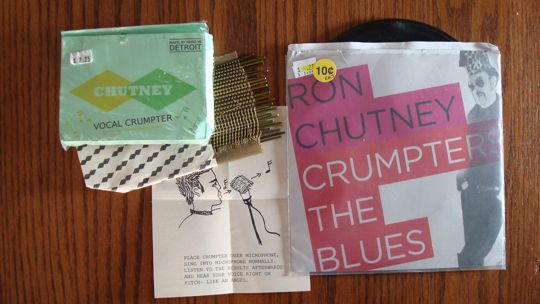
A crumpter, it turns out, is a sort of analog precedent to autotune. Never heard of that? Oh, well then, please read the story over at S.O.
And yes, all the collateral material Brown created is part of the auction.
We’ve sold a mystery object, we’ve sold a story that was itself an object, and now an object whose story is told in part through its packaging.
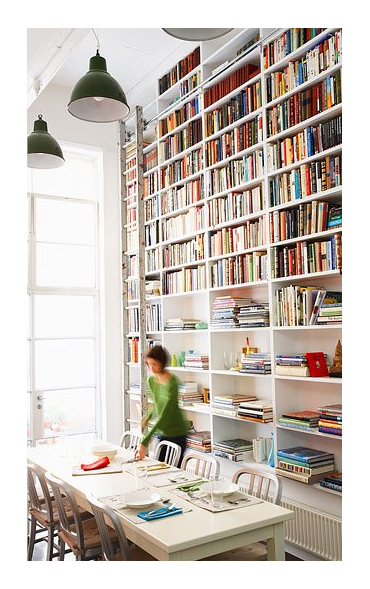
Dining room designed by Diane Bergeron Interiors. Click for more info.
Posted Under:
The Designed Life
This post was written by Rob Walker on April 7, 2010
Comments Off on Books, the idea: The classic book wall
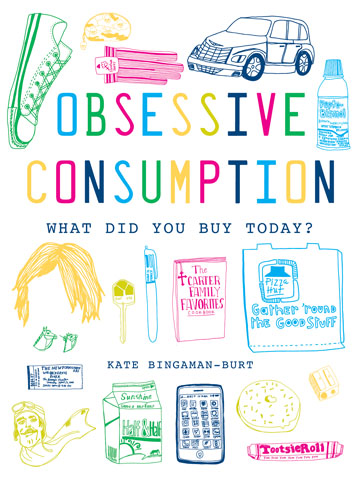
Kate Bingaman-Burt’s book. (Click pic for details.)
So above is the cover of Kate Bingaman-Burt’s new book. Below are some of the interpretations by assorted artists who love her.
I have NO IDEA how it feels to be on the receiving end of an astonishing creative outpouring such as this.
AMAZING.
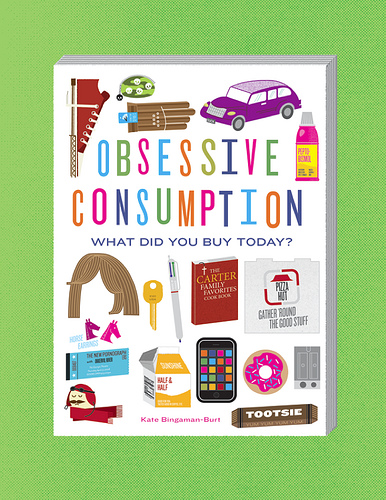
Frank Chimero
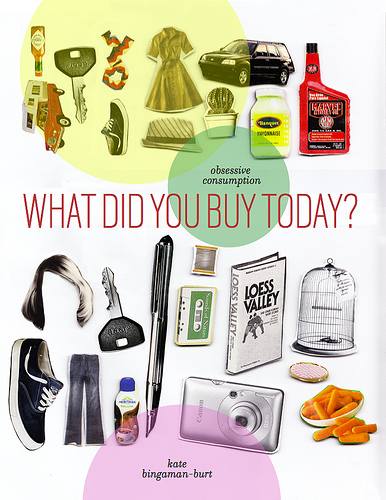
Lis Charman
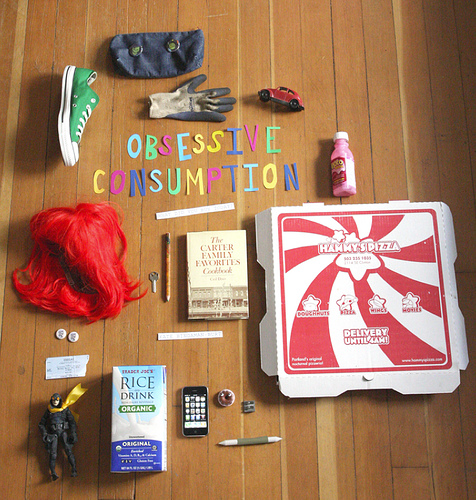
Lucy Berkley
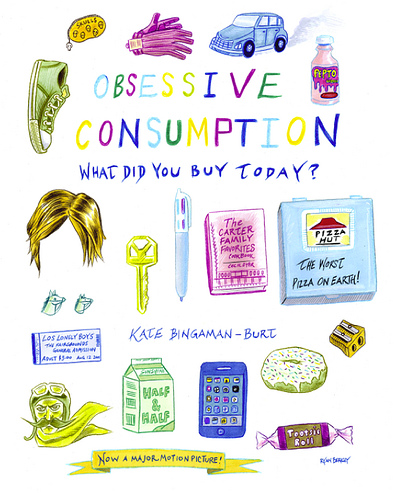
Ryan Berkley
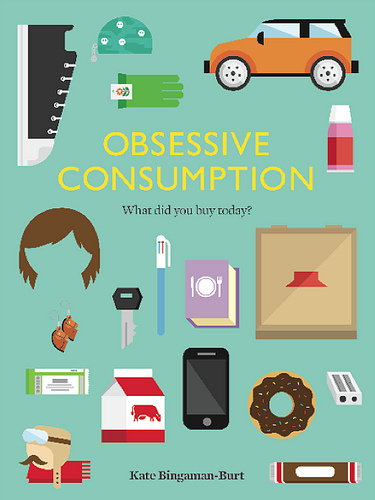
Always With Honor
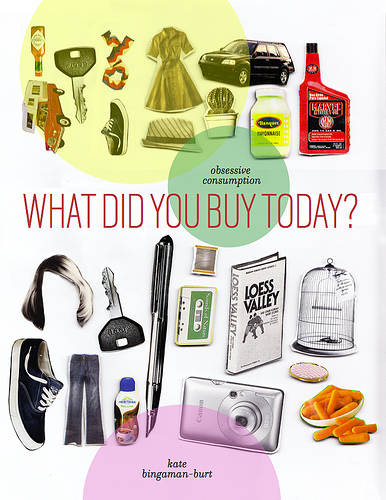
Lis Charman
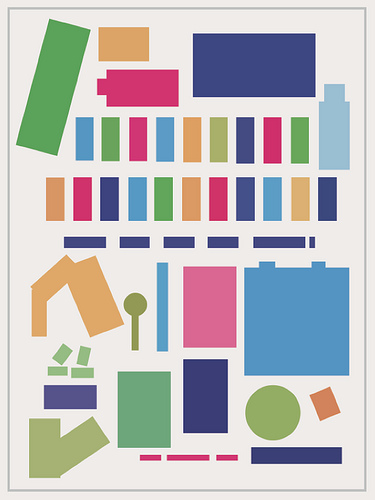
Jason Sturgill

Amy Ruppel
Posted Under:
Artists,
Pleasing
This post was written by Rob Walker on April 6, 2010
Comments Off on Pictures of Stuff: pictures of pictures of stuff edition
Apple said on Monday that it had sold more than 300,000 iPads on the device’s first day on the market, a figure that included preorders. That met the expectations of financial analysts who were keeping tabs on the release of the company’s highly anticipated tablet computer. … [RBC Capital] had been expecting Apple to sell 300,000 to 400,000 iPads over the whole weekend.
—NYT
Apple Inc. said it sold more than 300,000 iPads in the U.S. on the first day the device went on sale Saturday, tempering Wall Street’s highflying expectations for the much-hyped multimedia tablet computer. … Analysts on average had expected first-day iPad sales of 400,000 to 500,000 units. Some analysts, such as Piper Jaffray analyst Gene Munster, had even higher sales projections of 600,000 to 700,000 units.
— WSJ
Posted Under:
The Trend Industry
This post was written by Rob Walker on April 6, 2010
Comments Off on iPad expectations
This Smithsonian.com writeup on Penguin paperbacks makes some interesting observations about how their success was tied to their object-ness — both in terms of design and branding:
Penguin’s graphic design played a large part in the company’s success. Unlike other publishers, whose covers emphasized the title and author of the book, Penguin emphasized the brand. The covers contained simple, clean fonts, color-coding (orange for fiction, dark blue for biography) and that cute, recognizable bird. The look helped gain headlines. The Sunday Referee declared “the production is magnificent” and novelist J. B. Priestley raved about the “perfect marvels of beauty and cheapness.”
Posted Under:
The Designed Life
This post was written by Rob Walker on April 6, 2010
Comments Off on Books, the idea: “Beauty and cheapness”
- 200 Examples of anti-Obama merchandise: During health care debate, 2008-2010. Via Coudal.
- The joy (and pain) of abundance: “The overstuffed houses of hoarders and the ultra-minimal, bare bones interiors featured in design magazines are two ends of a spectrum of beliefs about homes and happiness. I could just as easily take on the hoarders as the zen-modernists, except for one thing — no one is advocating the hoarder lifestyle. Even the hoarders view their condition with shame. Minimalism, on the other hand, is often preached as a lifestyle nirvana — a blissful, transcendent state achieved by letting go of material things.” From a very enjoyable essay on aesthetics and abundance (including some thoughts about evolutionary factors that I’ve tried to articulate in the past, with little success, but that I agree with completely).
- Digital decay and the archival cloud: Interesting Nicholas Carr rumination on potential threats to digital archives kept in “the cloud.” My impression is that a lot of people are thinking about these problems, and that we’re still likely to end up with a massive glut of digital “information.” The quality of what gets kept may vary widely, of course.
- The nonexistent purpose of people: “When it comes to religion, most believers reason that we’re here ‘for’ some divine purpose. Even if they’re not particularly religious, people often reference some vague purpose to human existence, such as ‘to love one another’. As Albert Camus wrote, ‘revolt against man is also directed against God’. But many of us go one step further than this, saying that individual members of our species exist ‘for’ a special reason.” Via Mindhacks.
- The ROFLCon II Schedule @ ROFLCon.
- Can you judge an album by its cover?: Somebody is doing a study to find out. You can participate via this link if you like.
These links compiled via delicious, and repurposed here with plug-in Postalicious. Not enough stuff? Not the stuff you wanted? Try visiting unconsumption.tumblr.com, murketing.tumblr.com, and/or the Consumed Facebook page.
For obvious reasons the discussion of the idea of books has focused quite heavily on the e-variety these last few days, as speculation abounds over The Meaning of the iPad For The Printed Word.
The Telegraph reports on a book that will have a sort of instant sequel “assembled from the best comments by readers of” the author’s Website. A publishing type who is involved comments:
With devices like the iPad nearly at our shores and more routes for communication than ever before, I believe that especially in non-fiction, the distance between the author and reader should start to disappear. Authors will become more like curators and take influence from their readers’ suggestions during and after they have written their work.
Meanwhile, Nicholas Carr suggests that what we’re headed for is books becoming multimedia apps, in a sort of post-reader world. He quotes some other publishing-world guy:
“The definition of the book itself seems up for grabs,” he said at a recent media industry powwow. Unlike traditional e-book readers, which had a rather old-fashioned attachment to linear text, the iPad opens the doors to incorporating all sorts of “cool stuff,” Makinson continued. “We will be embedding audio, video and streaming into everything we do.” He foresees sprinkling movie clips among Jane Austen’s paragraphs in future editions of “Pride and Prejudice.”
Hm. What do you think?
Perhaps I’ll “curate” the best of your responses into a follow-up post!
With video?
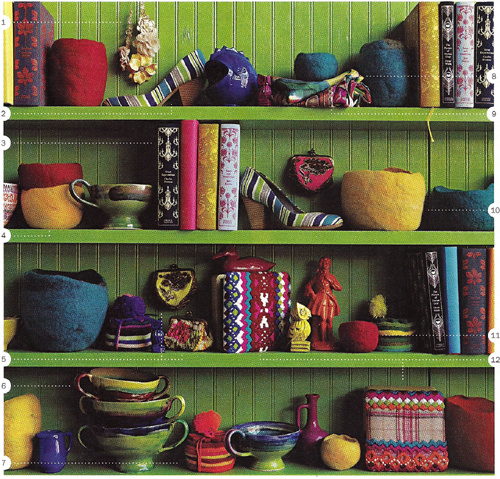
Via Jezebel, click for more.
In a thoughtful comment to a December 2009 post on Significant Objects (in which I noted examples of art made from books, and ruminated on the possibilities of “upcycling with words”), Jim Rosenau mentioned a Nicholson Baker New Yorker essay called “Books As Furniture.” I finally got around to tracking that down and reading it this weekend, and I must thank Mr. Rosenau. The piece, from 1995, is amazing.
It’s in the New Yorker archive, here, but I guess you have to be a subscriber to access it. It’s going to take me more than one post to deal with all the great observations in this essay (are you out there RAOJ?) but by chance there’s opening to get started today.
In a nutshell, Baker starts noticing the books used as props in home decor catalogs, and looks into it. And, you know, he does that Nicholson Baker thing, of learning a shocking amount, conveying it to us with one insight after another, and basically just making the whole experience a reading pleasure. More specifics in the days ahead, but in the short term I happened to become aware by coincidence just today that Jezebel (a site I visit rarely, not that there’s anything wrong with it) has a kind of recurring feature that involves … scrutinizing catalogs. The image at the top of this post, for instance, is from an Anthropologie catalog.
You’ll notice, of course, the books, looking quite pleasing there with all the other stuff on that just-so shelf. But those aren’t props (or at least not just props) like the books that Baker noticed in various catalogs: Anthropologie evidently actually sells ’em:
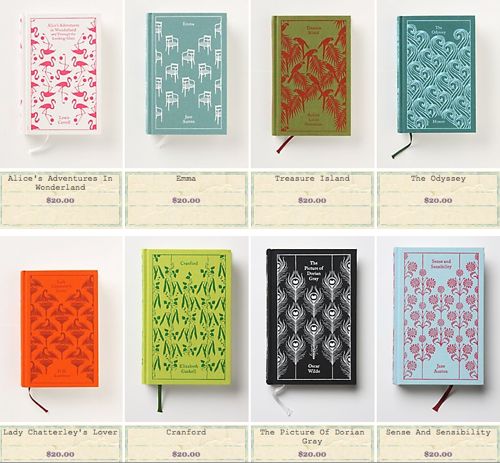
Anthropologie book selection. Click for more.
And let’s face it: They look great.
More on Baker’s 1995 piece as this series continues.
This Retro Thing post caught my eye:
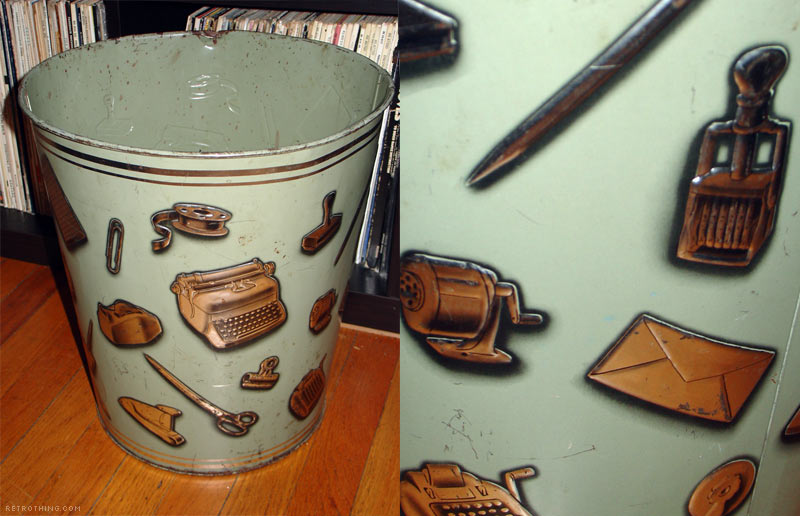
Via Retro Thing. Click to read Retrothing post.
It’s not just a thing decorated with images of other things, it’s a thing for discarding things, decorated with images of things.
This post is part of an occasional series.
Posted Under:
Things/Thinking
This post was written by Rob Walker on April 5, 2010
Comments Off on Pictures of Stuff: Stuff on an object
 Okay I so I dialed back the constant mentions of Significant Objects on this site, but this might be of interest to some of you: We have a special week-long event underway, a set of objects “curated” for us by an actual curator — Paola Antonelli, of MoMA — with the stories co-published on one of my very favorite sites, Core77. A story a day, all week.
Okay I so I dialed back the constant mentions of Significant Objects on this site, but this might be of interest to some of you: We have a special week-long event underway, a set of objects “curated” for us by an actual curator — Paola Antonelli, of MoMA — with the stories co-published on one of my very favorite sites, Core77. A story a day, all week.
Pretty cool. Proceeds for our current batch of object auctions are all going to Girls Write Now. Your help in spreading the word about this is always appreciated.
One or two more pieces of news about S.O. in the next week or so, but I promise not to get carried away.
Posted Under:
Things/Thinking
This post was written by Rob Walker on April 5, 2010
Comments Off on Significant Objects X Paola Antonelli X Core77
 SLIGHTLY USED
SLIGHTLY USED
What can we learn from our (seemingly) pointless tools?
A predictable thought crossed my mind: how funny, how absurd, that the cutting tool, the ur-thing of functionality, has evolved into a premium-priced stylish object that seems more suitable for display than for use. But after listening to the first 30 episodes of the radio series (it starts up again in May), which bring the story up to about 300 B.C., I’ve had second thoughts about that glib analysis.
Read the column in the April 4, 2010, New York Times Magazine, or here.
Discuss, make fun of, or praise this column to the skies at the Consumed Facebook page.
Posted Under:
Consumed,
Things/Thinking
This post was written by Rob Walker on April 4, 2010
Comments Off on In The New York Times Magazine: Slightly Used




 "
"

 IPAD ENVY
IPAD ENVY





























 Kim Fellner's book
Kim Fellner's book  A
A